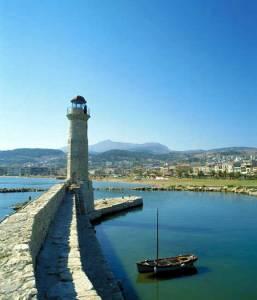|
Rethymno City

Rethymno Lighthouse |
Welcome to Rethymno!
The capital of the prefecture and sharing its name, Rethymno, is an incredible town of old and new, most well known for having one of the most beautiful Venetian harbors. Rethymno is a vibrant and charming city of about 30,000 inhabitants, situated on the north coast of Crete, between Chania to the west, and Iraklion to the east. It is, in fact, the third largest city on Crete.
Rethymno has a rich and long history. The original town came be during the classical years, 470-323 B.C. and was then known as Rithymna. It began to flourish during the Venetian occupation from 1204, during which time it became an important port due to its excellent geographical position for trade with the rest of the Aegean and the Peloponnese, and with the Arab countries. It was during this period that the fortress and the defending walls were built, protecting the town from pirates. It was also during this period that the townspeople came to develop and embrace literature, painting, theater and architecture. This continued until 1646, when Rethymno was conquered by the Turks.
From that time and until the Russian invasion in 1898, the population was involved primarily with agriculture. Culture again came to the forefront once Crete was reunited with Greece in 1913. The University of Crete was founded in Rethymno in 1974. Together with its campus in Heraklion, there are currently more than 10,000 full time students.
Within the confines of the city, you’ll find wonderful shops, places to eat and drink, historical sights to visit, and beautiful beaches easy to reach on foot. Since this is also a university town, you’ll always find a café, restaurant or bar open until the wee hours. The old part of the city combines Venetian and Turkish architecture, wonderfully interesting lanes and streets to stroll through, minarets, fountains, and, of course, the Venetian Port. While there, be sure to visit the Fortress Fortezza dating to 1573. Make a point of visiting also at sunset and wait until dark to view the walls and ramparts beautifully lit up along the coast.
Other highlights include the Neratzes Mosque, the largest of the five still remaining; the ancient Rimondi Fountain, renovated in 1626; and the Loggia, a building of Renaissance architecture dating to the 16th century, and with an interesting history. For museum lovers, there are several excellent choices. The Archaeological Museum features interesting finds from many excavations of the area dating as far back as the Neolithic period. The Center of Contemporary Art has a permanent exhibition and hosts other changing exhibits throughout the summer.
In a beautifully restored Venetian building near the Neratzes Mosque, you’ll find an outstanding exhibit of both rural and urban life dating back to the 17th century in the Historical and Folk Art Museum. The eclectic collection includes embroideries, jewelry, pottery, folklore items, photographs, coins, weapons and drawings, among others. For lovers of marine life, there is an excellent exhibit of shells, fish and sponges at the Marine Museum.
Together with all of the above, you will also find a wide range of accommodation choices and a fully developed tourist infrastructure combined with marvelous Cretan hospitality.

Rethymno Arcadi |
|

Rethymno City |
|

Rethymnon Fortetza Gate |
|

Rethymnon Preveli |
|

Rethymnon The Venetian Port of Rethymno |
|

Rethymno City |
|

Rethymno City |
|

Rethymno City |
|

Rethymno City |
|

Rethymno City, Rimondi Fountain |
|

Rethymno Castle |
|

Rethymno City |
|

Rethymno City |
|

Rethymno City |
|

Rethymno City Pavement Artist |
|

Rethymno City |
|
|
|
|
|



